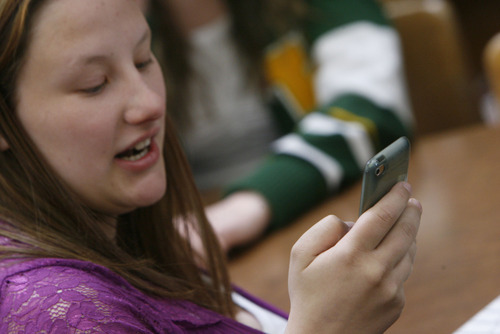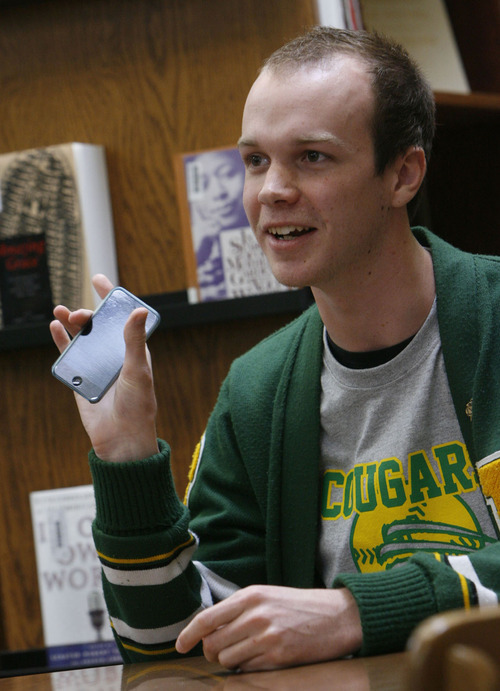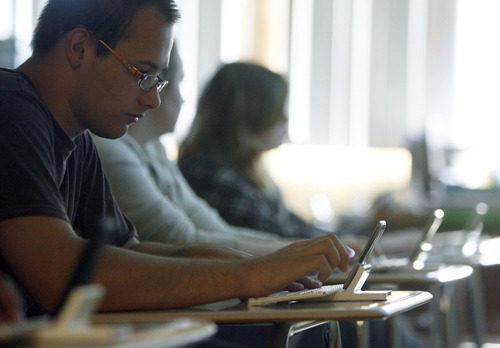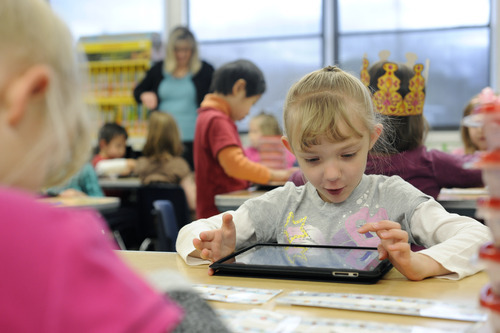This is an archived article that was published on sltrib.com in 2011, and information in the article may be outdated. It is provided only for personal research purposes and may not be reprinted.
With one hand, she twirled a blond pigtail. With the other, the kindergartner electronically dragged the letter C into place on her iPad crossword puzzle.
"Whoa!" 6-year-old Liz Delliskave exclaimed as she pulled the final letter of the two-word puzzle into position, triggering a graphic explosion of colorful circles, her reward for finishing the task.
"It's fun," Liz, a student at Viewmont Elementary in Murray, said of practicing spelling and math on the iPad. "You can do bunches of things."
Many Utah educators have embraced iPads and iPod touches this school year, saying they help engage students, allow them to work at their own levels and prepare them for the workplace of the future. Others worry the devices are distracting, overhyped and a waste of precious education dollars.
But such criticisms haven't stopped school districts across Utah and the nation from adopting them in ever-growing numbers.
At Viewmont, Liz's class of 24 kindergartners spends about 20 minutes a day working on iPads. At Kearns High, all of the nearly 1,700 students have iPod touches, which they use to read textbooks, write papers and do academic exercises.
The Provo District has a few hundred iPads in its schools, including in some fifth- and sixth-grade classrooms where students use them for as much as 70 percent of the day. The Piute District plans to have all its ninth-graders use iPads in the fall, said Rick Gaisford, educational technology specialist at the state Office of Education. In the Canyons District, one classroom at Sunrise Elementary and one classroom at Brighton High will soon get iPads for each student as part of a pilot program.
Even small, rural Escalante Valley Elementary School in Beryl has a couple of iPads for students to share.
"I love the instant feedback they can get without me saying 'Oh you missed that,' because there's no way I could get to all of them and provide that," said Viewmont kindergarten teacher Jennifer Lightfoot, who bought the iPads this year with a $16,000 grant from the state office. "It just gives us another way to tap into their learning."
—
Kindergartners and iPads • In Lightfoot's classroom on a recent day, tiny fingers zipped across iPad screens, navigating easily and quickly between applications.
When students first got the iPads, Lightfoot laid out a few rules to protect the $499 devices: Kindergartners must be seated to use them, no water allowed near them, no hitting them, no pounding their screens with fingers. But largely, she said, the students' ability to use them seems almost "instinctive." So far, they're all intact.
Some have expressed skepticism about giving iPads to children so young. Larry Cuban, a professor emeritus of education at Stanford University, said there's no question iPads engage children, but the devices alone are not enough to improve education. It's all about the programs on them and how teachers use them, he said.
"It is very novel and it has all the bells and whistles that will intrigue kids, but that doesn't make it necessarily a tool that can reach the teacher's purposes," Cuban said.
But Lightfoot said she uses the iPads to bolster instruction, not replace it. And she's not the first to put the touch-screen tablets into kindergartners' hands. Schools in Arizona, Maine, Nebraska, Ohio, West Virginia and Kentucky are also giving it a try.
"Everything they're doing has already been introduced to them and practiced in a traditional way," Lightfoot said. "None of them are just games in the sense they're wasting their time. They're all learning."
Parent volunteer Angela Muir said she sees it as an opportunity.
"It's the future, and if they can start learning it in kindergarten, I just think they're better off," Muir said.
She said her kindergartner comes home every day talking about it.
—
iPod high • Some Utah schools have gone even further with the new technologies.
In what may be the largest endeavor of its kind in Utah, every Kearns student was given an iPod touch this year, thanks to a $1 million federal stimulus Enhancing Education Through Technology grant.
Students use the handheld devices in class, take them home each night, and seniors who graduate on time will get to keep them after the school year ends. The idea is to see if the iPods improve academics, attendance and even graduation rates at Kearns, a school that has struggled to meet federal testing goals and serves many students from low-income families.
"The way to improve a school is to get students interested in school," said Rachel Murphy, the Kearns High library media specialist who's been managing the project."One thing we know about kids these days is they enjoy learning with technology. You have to reach the kids at their level."
Students say the devices, which cost the school around $200 each, have become invaluable. Tenth-grader Melissa Nistler said she sets her iPod to remind her to do her homework, with pop-up alerts.
Senior Laura Petersen keeps her U.S. government flashcards on the device, which she said helps her study more often. "Instead of carrying around a big, huge tote of flashcards, I can just pull out the iPod."
Hillary Loveless' iPod has helped her excel in Advanced Placement English despite having dyslexia. The senior class vice president listens to audio versions of assigned novels on her iPod. It's easier than finding and lugging around audio tapes or CDs, which is what she did in the past, she said.
Many Kearns teachers, who each received at least 45 hours of training on the iPods, are embracing them as well. More than 70 percent of teachers surveyed in February said they're using them in class, and schoolwide, students have access to nearly 500 different apps.School leaders won't have official data about whether the iPods helped improve attendance, academics or graduation until after the year ends.But in the survey, more than 60 percent of Kearns teachers said their students are more engaged in class.
Some initially worried the devices would be a distraction, but the biggest issue — more than students using them to e-mail friends or listen to music in class — has actually been students forgetting to bring their iPods to school, according to teachers surveyed.
On a recent school day, half of Spanish teacher Andrew Busath's class answered assigned questions by speaking Spanish into their iPod voice recorders. Then, with the touch of a button, they emailed the recordings to Busath, who walked around the classroom helping students as they worked. At the same time, the other half of Busath's class used an app to watch short Spanish videos and then took quizzes about them — all on their iPods.
Busath said the iPods also make it easier for students to practice Spanish outside of class.
"For learning a language, class time is not enough," Busath said. "It's really opening up their learning time."
—
Questions remain • Not everyone, of course, is as enthusiastic about the devices. Murphy said about a third of the Kearns teachers are still struggling to use them.
Also, it's no secret that some students email when they're supposed to be doing class work. But advocates say that is really no different than passing notes in class.
Others worry about the cost of the devices, especially in a time of tight school finances. Some Utah schools are paying for the devices out of school and district budgets. Others, such as Kearns and Viewmont, paid with grants.
Last year, Sen. John McCain, R-Ariz., and Sen. Tom Coburn, R-Okla., released a report listing the Kearns iPod project as one of 100 questionable uses of stimulus money nationwide.
Utah Republican Rep. Jason Chaffetz said he's open to iPods and iPads in the classroom but only if data show they're a better, smarter, cheaper way of doing things. He said such technologies have to be looked at within the context of current budgets.
"They're going to have to come up with a pretty good cost justification because on the surface, it doesn't smell right," Chaffetz said. "If we're going to spend $700 on an iPad, where would that money have been spent otherwise, because they're not cheap."
Some districts are taking a measured approach toward adopting the technologies. The Canyons District, for example, plans to fill two classrooms with iPads either at the end of this year or the beginning of next.
"We need to understand how the iPad can impact the education of the students before we go and buy them for the entire district," said Dean Glanville, Canyons director of technology architecture.
Still, Glanville is optimistic about the devices. Some educators say they could help schools save money in the long run as textbooks become available electronically. IPods and iPads can also be cheaper than computers.
"We really think that's going to be the future," said Jim Parkin, Provo district technology integration coordinator. "We think there will be less and less desktop computers and there will be more of these smaller devices."
Murphy said many people don't understand iPods' capabilities because they've been promoted as music and gaming devices. "There's so much more to them than that," she said.
twitter: @lschencker —
Teacher uses iPod touch to clone himself
One Kearns High teacher has figured out how to use his iPod touch to fulfill a desire on nearly every teacher's wish list: more help in the classroom.
Pene Talamaivao, a special education language arts teacher, has cloned himself using his iPod. He makes 10- to 20-minute videos of himself teaching on the iPod and then projects the videos onto a screen at the front of his classroom. While the video rolls, Talamaivao takes attendance, hands out papers and addresses individual students' concerns.
He calls the video version of himself his alter-ego — "Mr. P" — and has been known to interact with it, having mock arguments and conversations with himself to engage students.
"I realized that if I could clone myself and have him do most of the presenting, I can do other work," Talamaivao said.
"It's like having another aide in there," said Principal Stephen Hess.
Talamaivao doesn't do that in every class, wanting to keep things fresh for his students. But it's a routine that's become famous throughout the school.
"Education has been the same for so long, and I think what the iPod has done is — the teachers are great — but it has added a little something extra to us," Talamaivao said. —
Educational apps abound
Here are examples of the types of applications students use at Kearns High on their iPod touches:
• Anatomy Body Facts
• Beginning German
• Flashcard Touch
• FREE Spanish Tutor
• myGovernment
• SAT Word Scramble















